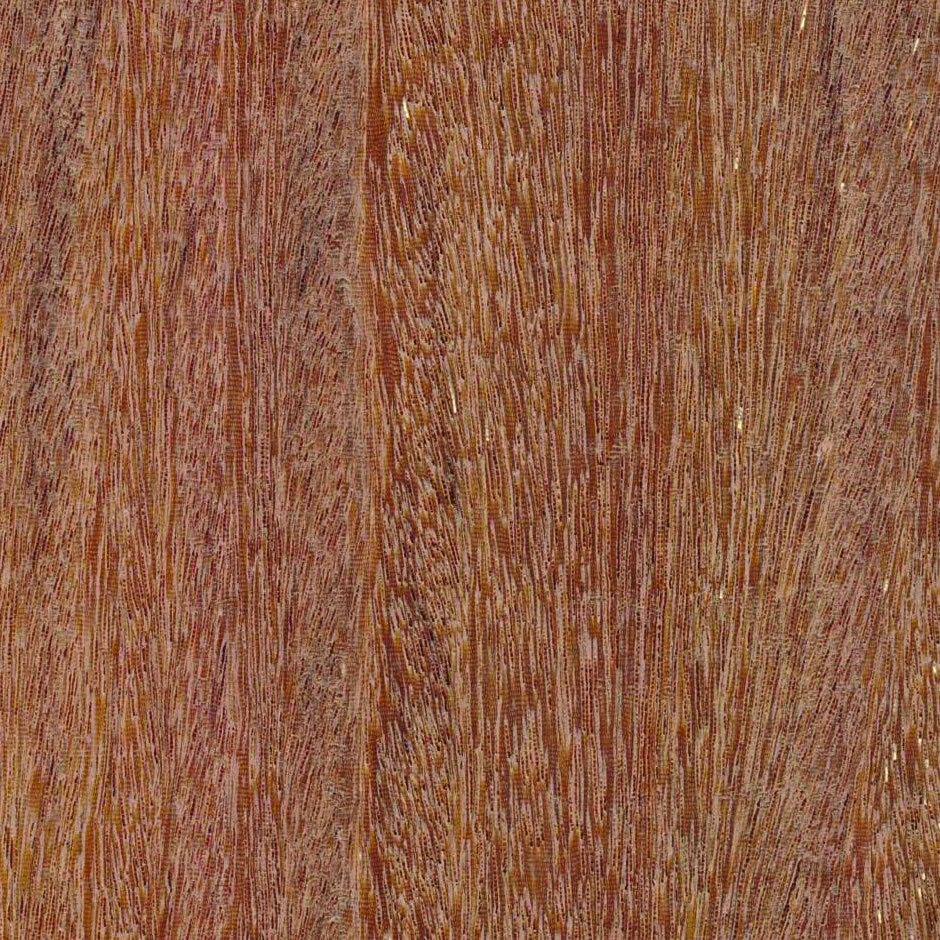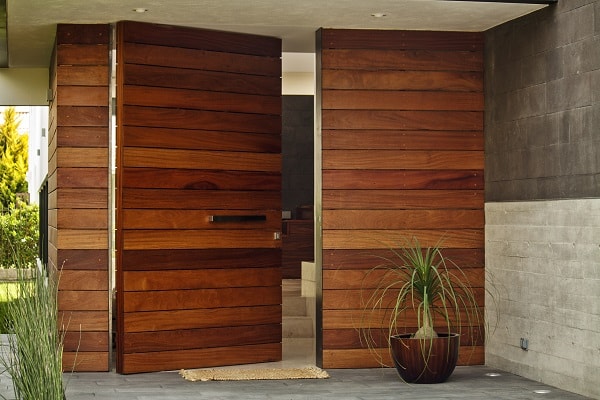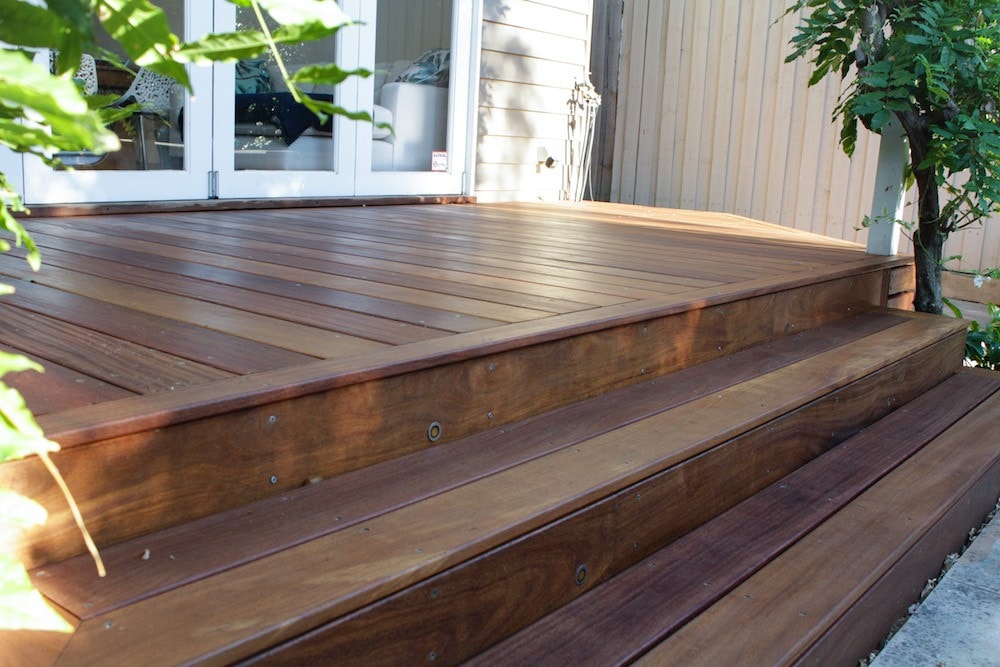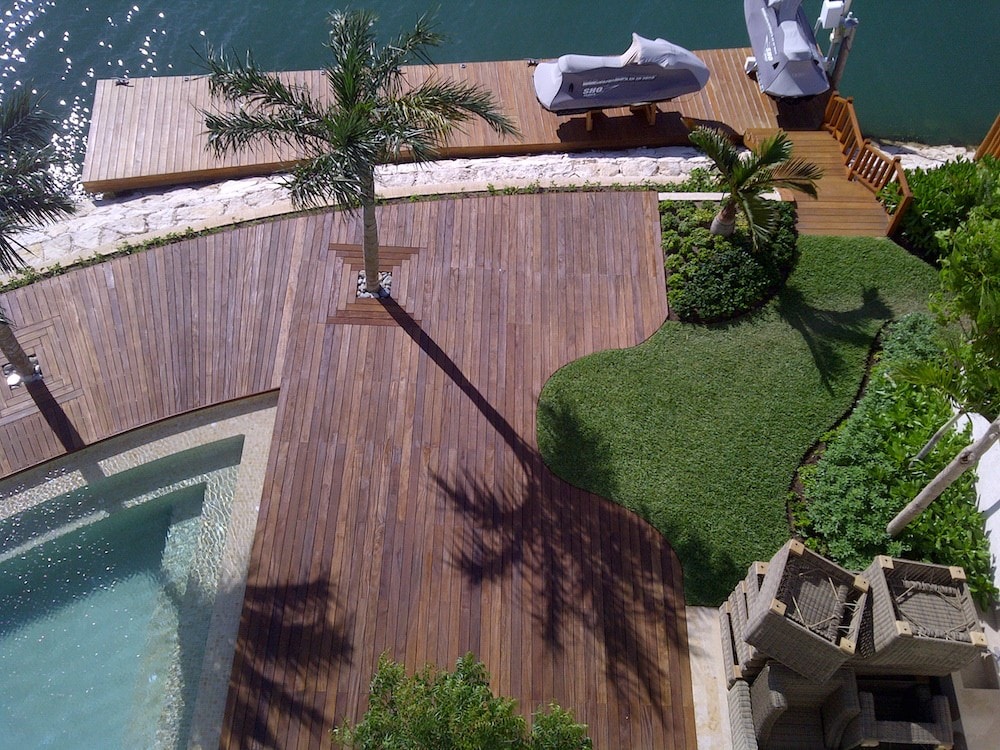Dipteryx odorata

Technical Features
Porta Cumaru is an extremely strong timber with a very high density of 1,085 kg/m3. It meets the requirement as a BAL 19 timber as specified in AS 3959-2 2018 for use in timber construction in bushfire zones. Porta Cumaru is a Class 1 timber with an above-ground life expectancy of greater than 40 years and in-ground of greater than 25 years. It is also termite resistant.
Visual Features
Porta Cumaru is an attractive timber, with a unique interlocking grain. Mid-brown in colour with a reddish or purple hue when cut changing to brown with red or gold flecks. It can age to a lustrous grey if left uncoated.
Workability
Pre-drilling for screwing or nailing when installing decking is recommended. Its inherent hardness has a blunting effect on tool cutting edges, therefore saws/chisels/drills etc. need to be sharpened more often. It can be sanded, oiled and painted very easily. Porta recommends using an oil-based paint/stain preparations due to its high timber density, as water-based products have minimal penetration for long-term coating durability. Compared to other hardwoods tested Porta Cumaru demonstrated near-zero tannin bleed. However Porta recommends cleaning of timber prior to installation and a suitable sealer to protect the timber and minimise any potential run off of natural resins onto surrounding surfaces.
Applications
Porta Cumaru is ideal for applications where a durable timber is needed such as decking & cladding applications.
Photo Gallery
Cumaru FAQ’s
Density kg/m3 dry (1) = 1085 Durability in ground (2) = Class 1 – 25yrs+ Resistance to Split (Nailing) = Good Specific Gravity (1) = 1.0 Durability above ground (2) = Class 1 – 40yrs+ Resistance to Split (Screwing = Good Hardness (Janka kN) (1) = 14.8 Susceptible to Lyctid Borer = No Gluing = Fair Modulus of Rupture MPa dry (1) = 175 Termite Resistance = Resistant Machining = Good Modulus of Elasticity GPa dry (1) = 22 BAL Rating (3) = 19 Finish = Good Radial Shrinkage % (1) = 5.3 Bending = Poor Stability = Excellent Tangential Shrinkage % (1) = 7.7 Sanding = Good Growing Region = South America Bleed* = Near-zero (1) Wood Solutions (2) Expected performance (3) Australian Forest Research Company 20161118 (May 2017) (4) AS 3959 Construction of buildings in bushfire-prone areas *Compared to other hardwoods tested Porta Cumaru demonstrated no apparent or near-zero tannin bleed. However, Porta recommends cleaning of timber prior to installation and using a suitable sealer to protect the timber and minimise any potential run-off of natural resins onto surrounding surfaces.
Product: Timber will be Porta Cumaru (Dipteryx odorata). Technical Features: FSC® certified, near-zero tannin bleed, with a density of 1,085 Kg/m3, certified Class 1 durability to AS 5604 natural durability above ground and resistant to Australian termites, min. Janka hardness of 14.8kN, a seasoned structural rating of F34 (beams) and bearer and joist width must not be less than 45mm, MOE of 22GPa, MOR of 175MPa, or unseasoned rating of F27 (posts). Where unseasoned Porta Cumaru timber is used, appropriate construction procedures must be adopted to compensate for the shrinkage. Porta Cumaru timber supplied for structural purposes such as posts, bearers and/or joists shall comply to AS 2082 and deck boards timber shall comply with AS 2796. Porta Cumaru timber should be pre-finished in the factory and a quality coating applied on all sides. Cut edges should be end sealed. Certification: Porta will provide a compliance guarantee with all orders indicating the Porta Cumaru timber has FSC® certification.
Porta Cumaru has been used in a broad range of demanding external and internal construction in domestic housing, commercial construction, and landscaping/civil projects.
Logging by certified suppliers protects the forest from forest clearing and unsustainable processes. Our supplier harvests less than 1 tree per hectare every 20 years. Our supplier carefully selects the trees to harvest and follows FSC® directed low impact techniques ensuring preservation and investment of the forest, source of income for the workers, preserving the wildlife, and supporting local economy.
Porta Cumaru is FSC® certified as being responsibly harvested and processed using responsible forest management and practices and certified by a third-party organization. This assures that Porta Cumaru protects the forests biodiversity and ecological processes. Buying FSC® certified timber helps support sustainable forest management, which reduces the emission of greenhouse gases and protects wildlife habitats. Porta is committed to sourcing timber from sustainable and environmentally responsible resources. By focusing on certified timber, we are helping maintain the ecological, sociocultural and economic balance of forest environments by preserving the world’s forests for generations to come.
Porta Cumaru is sourced from sustainably managed forests in Peru. Our supplier is FSC® certified and harvests the timber in a manner that preserves the forests, wildlife and surrounding communities for future generations. Porta holds Chain of Custody certification which means our suppliers are certified.
Yes, Porta has conducted laboratory nailplate fixing trials and found the nailplates can produce a stable joint when used with Cumaru timber.
Porta Cumaru has been used in external exposed applications such as board walks and wharves, for many years. Our trials show Porta Cumaru withstands severe weather exposure and our experience is that it is highly durable.
Cumaru is ideal for use in external applications such as posts and landscaping. For maximum performance, set posts in concrete to protect them against water. In landscaping applications provide good drainage and protect the timber from static water, where possible.




